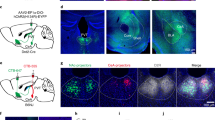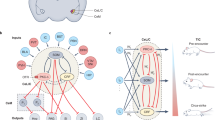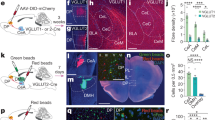Abstract
The bed nucleus of the stria terminalis (BNST) is a forebrain region implicated in aversive responses to uncertain threat. Much of the work on the role of BNST in defensive behavior has used Pavlovian paradigms in which the subject reacts to aversive stimuli delivered in a pattern determined entirely by the experimenter. Here, we explore the contribution of BNST to a task in which subjects learn a proactive response that prevents the delivery of an aversive outcome. To this end, male and female rats were trained to shuttle during a tone to avoid shock in a standard two-way signaled active avoidance paradigm. Chemogenetic inhibition (hM4Di) of BNST attenuated the expression of the avoidance response in male but not female rats. Inactivation of the neighboring medial septum in males produced no effect on avoidance, demonstrating that our effect was specific to BNST. A follow up study comparing hM4Di inhibition to hM3Dq activation of BNST in males replicated the effect of inhibition and demonstrated that activation of BNST extended the period of tone-evoked shuttling. These data support the novel conclusion that BNST mediates two-way avoidance behavior in male rats and suggest the intriguing possibility that the systems underlying proactive defensive behavior are sex-specific.
This is a preview of subscription content, access via your institution
Access options
Subscribe to this journal
Receive 13 print issues and online access
$259.00 per year
only $19.92 per issue
Buy this article
- Purchase on Springer Link
- Instant access to full article PDF
Prices may be subject to local taxes which are calculated during checkout





Similar content being viewed by others
References
American Psychiatric Association (2013) Diagnostic and statistical manual of mental disorders (5th ed). Arlington, VA.
LeDoux JE, Moscarello JM, Sears R, Campese V. The birth, death and resurrection of avoidance: a reconceptualization of a troubled paradigm. Mol Psychiatry. 2017;22:24–36.
Moscarello JM, Hartley CA. Agency and the calibration of motivated behavior. Trends Cogn Sci. 2017;21:725–35.
Kingston J, Clarke S, Remington B. Experiential avoidance and problem behavior: a mediational analysis. Behav Modif. 2010;34:145–63.
Nesse RM. Natural selection and the regulation of defenses. Evolut Hum Behav. 2005;26:88–105.
Fanselow MS, Lester LS (1988). A functional behavioristic approach to aversively motivated behavior: Predatory imminence as a determinant of the topography of defensive behavior. In R. C. Bolles & M. D. Beecher (Eds.), Evolution and learning (pp. 185–212). Lawrence Erlbaum Associates, Inc.
Mobbs D, Headley DB, Ding W, Dayan P. Space, time, and fear: survival computations along defensive circuits. Trends Cogn Sci. 2020;24:228–41.
Mobbs D, Kim JJ. Neuroethological studies of fear, anxiety, and risky decision-making in rodent and humans. Curr Opin Behav Sci. 2015;5:8–15.
Perusini JN, Fanselow MS. Neurobehavioral perspectives on the distinction between fear and anxiety. Learn Mem. 2015;22:417–25.
Choi JS, Cain CK, LeDoux JE. The role of amygdala nuclei in the expression of auditory signaled two-way active avoidance in rats. Learn Mem. 2010;17:139–47.
Kamin LJ, Brimer CJ, Black AH. Conditioned suppression as a monitor of fear of the CS in the course of avoidance training. J Comp Physiol Psychol. 1963;56:497–501.
LaPointe T, Worr M, Leri F. Analysis of memory modulation by conditioned stimuli. Learn Mem. 2021;28:87–94.
Mineka S, Gino A. Dissociation between conditioned emotional response and extended avoidance performance. Learn Motiv. 1980;11:476–502.
Moscarello JM. Prefrontal cortex projections to the nucleus reuniens suppress freezing following two-way signaled avoidance training. Learn Mem. 2020;27:119–23.
Moscarello JM, LeDoux JE. Active avoidance learning requires prefrontal suppression of amygdala-mediated defensive reactions. J Neurosci. 2013;33:3815–23.
Clauss JA, Avery SN, Benningfield MM, Blackford JU. Social anxiety is associated with BNST response to unpredictability. Depress Anxiety. 2019;36:666–75.
Davis M, Walker DL, Miles L, Grillon C. Phasic vs sustained fear in rats and humans: role of the extended amygdala in fear vs anxiety. Neuropsychopharmacology. 2010;35:105–35.
Goode TD, Acca GM, Maren S. Threat imminence dictates the role of the bed nucleus of the stria terminalis in contextual fear. Neurobiol Learn Mem. 2020;167:107116.
Goode TD, Ressler RL, Acca GM, Miles OW, Maren S. Bed nucleus of the stria terminalis regulates fear to unpredictable threat signals. eLife. 2019;8:e46525.
Grupe DW, Nitschke JB. Uncertainty and anticipation in anxiety: an integrated neurobiological and psychological perspective. Nat Rev Neurosci. 2013;14:488–501.
Armbuster BN, Li X, Pausch MH, Herlitze S, Roth BL. Evolving the lock to fit the key to create a family of G protein-coupled receptors potently activated by an inert ligand. Proc Natl Acad Sci. 2007;104:5163–8.
Lázaro-Muñoz G, LeDoux JE, Cain CK. Sidman instrumental avoidance depends on lateral and basal amygdala and is constrained by central amygdala-mediated pavlovian processes. Biol Psychiatry. 2010;67:1120–7.
Swanson LW (2004) Brain maps: structure of the rat brain, 3rd edition.
Rodriguez-Sierra OE, Turesson HK, Paré D. Contrasting distribution of physiological cell types in different regions of the bed nucleus of the stria terminalis. J Neurophysiol. 2013;110:2017–49.
Mazzone CM, Pati D, Michaelides M, DiBerto J, Fox JH, Tipton G, et al. Acute engagement of Gq-mediated signaling in the bed nucleus of the stria terminalis induces anxiety-like behavior. Mol Psychiatry. 2018;23:143–53.
Gungor NZ, Paré. Functional heterogeneity in the bed nucleus of the stria terminalis. J Neurosci. 2016;36:8038–49.
Ramirez F, Moscarello JM, LeDoux JE, Sears RM. Active avoidance requires a serial basal amygdala to nucleus accumbens circuit. J Neurosci. 2015;35:34703477.
Glover LR, McFadden KM, Bjorni M, Smith SR, Rovero NG, Oreizi-Esfahani S, et al. A prefrontal-bed nucleus of the stria terminalis circuit limits fear to uncertain threat. eLife. 2020;9:e60812.
Dabrowska J, Martinon D, Moaddab M, Rainnie DG (2016) Targeting corticotropin-releasing factor projections from the oval nucleus of the bed nucleus of the stria terminalis using cell-type specific neuronal tracing studies in mouse and rat brain. J Neuroendocrinol. 28: https://doi.org/10.1111/jne12442.
Shackman AJ, Fox AS. Contributions of the central extended amygdala to fear and anxiety. J Neurosci. 2016;36:8050–63.
Yetnikoff L, Lavezzi HN, Reichard RA, Zahm DS. An update of the connections of the ventral mesencephalic dopaminergic complex. Neuroscience. 2015;282:23–48.
del Abril A, Segovia S, Guillamón A. The bed nucleus of the stria terminalis in the rat: regional sex differences controlled by gonadal steroids early after birth. Dev Brain Res. 1987;32:295–300.
Hines M, Allen LS, Gorski RA. Sex differences in subregions of the medial nucleus of the amygdala and the bed nucleus of the stria terminalis of the rat. Brain Res. 1992;579:321–6.
Shah NM, Pisapia DJ, Maniatis S, Mendelsohn MM, Nemes A, Axel R. Visualizing sexual dimorphism in the brain. Neuron. 2004;43:313–9.
Tsukahara S, Morishita M. Sexually dimorphic formation of the preoptic area and the bed nucleus of the stria terminalis by neuroestrogens. Front Neurosci. 2020;14:797.
Uchida K, Otsuka H, Morishita M, Tsukahara S, Sato T, Sakimura K, et al. Female-biased sexual dimorphism of corticotropin-releasing factor neurons in the bed nucleus of the stria terminalis. Biol Sex Differ. 2019;10:6.
Ge M, Balleine BW. The role of the bed nucleus of the stria terminalis in the motivational control of instrumental action. Front Behav Neurosci. 2022;16:968593.
Bjorni M, Rovero NG, Yang ER, Holmes A, Halladay LR. Phasic signaling in the bed nucleus of the stria terminalis during fear learning predicts within- and across-session cued fear expression. Learn Mem. 2020;27:83–90.
Hott SC, Gomes FV, Uliana DL, Vale GT, Tirapelli CR, Resstel LBM. Bed nucleus of the stria terminalis NMDA receptors and nitric oxide modulate contextual fear conditioning in rats. Neuropharmacology. 2017;112(part A):135–43.
Sullivan GM, Apergis J, Bush DEA, Johnson LR, Hou M, LeDoux JE. Lesions of the bed nucleus of the stria terminalis disrupt corticosterone and freezing responses elicited by a contextual but not by a specific cue-conditioned fear stimulus. Neuroscience. 2004;128:7–14.
Zimmerman JM, Maren S. The bed nucleus of the stria terminalis is required for the expression of contextual but not auditory freezing in rats with basolateral amygdala lesions. Neurobiol Learn Mem. 2011;95:199–205.
Urien L, Stein N, Ryckman A, Bell L, Bauer EP. Extended amygdala circuits are differentially activated by context fear conditioning in male and female rats. Neurobiol Learn Mem. 2021;180:107401.
Hammack SE, Todd TP, Kocho-Schellenberg M, Bouton ME. Role of the bed nucleus of the stria terminalis in the acquisition of contextual fear at long or short context-shock intervals. Behav Neurosci. 2015;129:673–8.
Asok A, Draper A, Hoffman AF, Schulkin J, Lupicia CR, Rosen JB. Optogenetic silencing of a corticotropin-releasing factor pathway from the central amygdala to the bed nucleus of the stria terminalis disrupts sustained fear. Mol Psychiatry. 2018;23:914–22.
Bruzsik B, Biro L, Zelena D, Sipos E, Szebik H, Sarosdi KR, et al. Somatostatin neurons of the bed nucleus of stria terminalis enhance associative fear memory in mice. J Neurosci. 2021;41:1982–95.
Waddell J, Morris RW, Bouton ME. Effects of bed nucleus of the stria terminalis on conditioned anxiety: aversive conditioning with long-duration conditional stimuli and the reinstatement of extinguished fear. Behav Neurosci. 2006;120:324–36.
Davis M, Walker DL. Role of the bed nucleus of the stria terminalis and amygdala AMPA receptors in the development and expression of context conditioning and sensitization of startle by prior shock. Brain Struct Funct. 2014;219:1969–82.
Totty MS, Warren N, Huddleston I, Ramanathan KR, Ressler RL, Oleksiak CR, et al. Behavioral and brain mechanisms mediating conditioned flight behavior in rats. Sci Rep. 2021;11:8215.
Avery SN, Clauss JA, Blackford JU. The human BNST: functional role in anxiety and addiction. Neuropsychopharamcology. 2016;41:126–41.
LeBow MA, Chen A. Overshadowed by the amygdala: the bed nucleus of the stria terminalis emerges as key to psychiatric disorders. Mol Psychiatry. 2016;21:450–63.
Turresson HK, Rodríguez-Sierra OE, Pare D. Intrinsic connections in the anterior part of the bed nucleus of the stria terminalis. J Neurophysiol. 2013;109:2438–50.
Bruzsik B, Biro L, Sarosdi KR, Zelena D, Sipos E, Szebik H, et al. Neurochemically distinct populations of the bed nucleus of stria terminalis modulate innate fear response to weak threat evoked by predator odor stimuli. Neurobiol Stress. 2021;15:100415.
Crowley NA, Bloodgood DW, Hardaway A, Kendra AM, McCall JG, Al-Hasani R, et al. Dynorphin controls the gain of an amygdalar anxiety circuit. Cell Rep. 2016;14:2774–83.
Giardino WJ, Eban-Rothschild A, Christoffel DJ, Li S-B, Malenka RC, de Lecea L. Parallel circuits from the bed nucleus of stria terminalis to the lateral hypothalamus drive opposing emotional states. Nature. 2018;21:1084–95.
Jennings JH, Sparta DR, Stamatakis AM, Ung RL, Pleil KE, Kash TL, et al. Distinct extended amygdala circuits for divergent motivational states. Nature. 2013;496:224–8.
Kim S-Y, Adhikari A, Lee SY, Marshel JH, Kim CK, Mallory CS, et al. Diverging neural pathways assemble a behavioural state from separable features of anxiety. Nature. 2013;496:219–23.
Luskin AT, Bhatti DL, Mulvey B, Pederson CE, Girven KS, Oden-Brunson H, et al. Extended amygdala-parabrachial circuits alter threat assessment and regulate feeding. Sci Adv. 2021;7:eabd3666.
Ciocchi S, Herry C, Grenier F, Wolff JJ, Vlachos I, Ehrlich I, et al. Encoding of conditioned fear in central amygdala inhibitory circuits. Nature. 2010;468:277–82.
Fadok JP, Krabbe S, Markovic M, Courtin J, Xu C, Massi L, et al. A competitive inhibitory circuit for selection of active and passive fear responses. Nature 2017;542:96–100.
Gozzi A, Jain A, Giovannelli A, Bertollini C, Crestan V, Schwarz AJ, et al. A neural switch for active and passive fear. Neuron 2010;67:656–66.
Sagvolden T, Johnsrud G. Two-way active avoidance learning following medial, dorsolateral, or total septal lesions in rats: effects of intensity of discontinuous shock. Behav Neural Biol 1982;35:17–32.
Torras-Garcia M, Costa-Miserachs D, Morgado-Bernal I, Portell-Cortés I. Improvement of shuttle-box performance by anterodorsal septal lesions in rats. Behav Brain Res. 2003;141:147–58.
Laughlin LC, Moloney DM, Samels SB, Sears RM, Cain CK. Reducing shock imminence eliminates poor avoidance in rats. Learn Mem. 2020;27:270–4.
Cain CK. Avoidance problems reconsidered. Curr Opin Behav Sci. 2019;26:9–17.
Moscarello JM, Penzo MA. The central nucleus of the amygdala and the construction of defensive modes across the threat-imminence continuum. Nat Neurosci. 2022;25:999–1008.
Lima SL, Dill LM. Behavioral decisions made under the risk of predation: a review and prospectus. Can J Zool. 1990;68:619–40.
Knight LK, Depue BE. New frontiers in anxiety research: the translational potential of the bed nucleus of the stria terminalis. Front Psychiatry. 2019;10:510.
LeBow MA, Chen A. Overshadowed by the amygdala: the stria terminalis emerges as key to psychiatric disorders. Mol Psychiatry. 2016;21:450–63.
Miles OW, Maren S. Role of the bed nucleus of the stria terminalis in PTSD: insights from preclinical models. Front Behav Neurosci. 2019;13:68.
Blakey SM, Abramowitz JS. The effects of safety behaviors during exposure therapy for anxiety: Critical analysis from an inhibitory learning perspective. Clin Psychol Rev. 2016;49:1–15.
Meacham F, Bergstrom C. Adaptive behavior can produce maladaptive anxiety due to individual differences in experience. Evol Med Public Health 2016;2016:270–85.
Acknowledgements
We thank Dr. Jun Wang for providing the CNO for our slice physiology experiment.
Funding
This work was supported by NIH grant R21MH126327 (JMM) and BBRF NARSAD48 Young Investigator Award 25196 (JMM). The authors have no competing financial interests to disclose.
Author information
Authors and Affiliations
Contributions
DPG assisted in the design of the behavioral experiments, executed those experiments, assisted in the analysis of behavioral data, performed the relevant histology, and contributed to the writing manuscript. WW and KS designed and executed the physiological experiment and edited the manuscript. JM designed the behavioral experiments and supervised their execution, analyzed behavioral data, and wrote the manuscript.
Corresponding author
Ethics declarations
Competing interests
The authors declare no competing interests.
Additional information
Publisher’s note Springer Nature remains neutral with regard to jurisdictional claims in published maps and institutional affiliations.
Rights and permissions
Springer Nature or its licensor (e.g. a society or other partner) holds exclusive rights to this article under a publishing agreement with the author(s) or other rightsholder(s); author self-archiving of the accepted manuscript version of this article is solely governed by the terms of such publishing agreement and applicable law.
About this article
Cite this article
Guerra, D.P., Wang, W., Souza, K.A. et al. A sex-specific role for the bed nucleus of the stria terminalis in proactive defensive behavior. Neuropsychopharmacol. 48, 1234–1244 (2023). https://doi.org/10.1038/s41386-023-01581-9
Received:
Revised:
Accepted:
Published:
Issue Date:
DOI: https://doi.org/10.1038/s41386-023-01581-9



